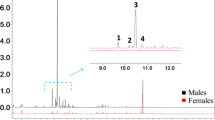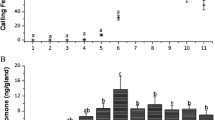Abstract
Analyses of the headspace volatiles produced by males and females of Sternechus subsignatus Boheman (Coleoptera: Curculionidae) revealed seven male-specific compounds. The major component was (E)-2-(3,3-dimethylcyclohexylidene)-ethanol, and the minor components were 1-(2′-hydroxyethyl)-1-methyl-2-isopropenylcyclobutane (grandisol), 7-methyl-3-methyleneoct-6-en-1-ol, (Z)-2-(3,3-dimethylcyclohexylidene)-ethanol, (Z)- and (E)-2-(3,3-dimethylcyclohexylidene)-acetaldehyde, and (E)-2-(3,3-dimethylcyclohexylidene) acetic acid. The latter compound is described for the first time as a natural product. Only four of the seven identified compounds showed electrophysiological activity. Enantioselective gas chromatography showed that the natural grandisol is the (1R,2S)-stereoisomer. The major component, (E)-2-(3,3-dimethylcyclohexylidene)-ethanol, attracted S. subsignatus in olfactometer bioassays. Studies are in progress to evaluate the biological activity of the major component and the EAD-active mixture under field conditions.





Similar content being viewed by others
References
Ambrogi, B. G., and Zarbin, P. H. G. 2008. Aggregation pheromone in Sternechus subsignatus (Coleoptera: Curculionidae): Olfactory behaviour and temporal pattern of emission. J. Appl. Entomol. 132:54–58.
Bartelt, R. J. 1999. Sap beetles, pp. 69–90, in J. Hardie and A. K. Minks (eds.), Pheromones of non-Lepidopteran Insects Associated with Agricultural Plants. CABI, Wallingford, England.
Bedoukian, R. H., and Wolinsky, J. 1975. A biogenetic-type synthesis of the cyclohexyl constituents of the boll weevil pheromone. J. Org. Chem. 40:2154–2156.
Booth, D. C., Phillips, T. W., Claesson, A., Silverstein, R. M., Lanier, G. N., and West. J. R. 1983. Aggregation pheromone components of two species of Pissodes weevil (Coleoptera:Curculionidae): Isolation, identification, and field activity. J. Chem. Ecol. 9:1–12.
Eller, F. J., and Bartelt, R. J. 1996. Grandisoic acid, a male-produced aggregation pheromone from the plum curculio, Conotrachelus nenuphar. J. Nat. Prod. 59:451–453.
Eller, F. J., Bartelt, R. J., Shasha, B. S., Schuster, D. J., Riley, D. G., Stansly, P. A., Mueller, T. F., Shuler, K. D., Johnson, B., Davis, J. H., and Sutherland, C. A. 1994. Aggregation pheromone for the pepper weevil, Anthonomus eugenii cano (Coleoptera: Curculionidae): Identification and field activity. J. Chem. Ecol. 20:1537–1555.
Francke, W., and Dettner, K. 2005. Chemical signalling in beetles. Topics in Curr. Chem. 240:85–166.
Hedin, P. A., Dollar, D. A., Collins, J. K., Dubois, J. G., Mulder, P. G., Hedger, G. H., Smith, M. W., and Eikenbary, R. D. 1997. Identification of male pecan weevil pheromone. J. Chem. Ecol. 23:965–977.
Henson, R. D., Bull, D. L., Ridgway, R. L., and Ivie, G. W. 1976. Identification of the oxidative decomposition products of the boll weevil pheromone, grandlure, and the determination of the fate of grandlure in soil and water. J. Agric. Food Chem. 24:228–231.
Hoffmann-Campo, C. B., De Oliveira, E. B., and Mazzarin, R. M. 1990. Níveis de infestação de Sternechus subsignatus Boheman, 1836: influência nos rendimentos e características agronômicas da soja. Pesq. Agrop. Bras. 25:221–227.
Hoffmann-Campo, C. B., Parra, J. R. P., and Mazzarin, R. M. 1991. Ciclo biológico, comportamento e distribuição estacional de Sternechus subsignatus Boheman, 1836 (Col.: Curculionidae) em soja, no norte do Paraná. Rev. Bras. Biol. 51:615–621.
Innocenzi, P. J., Hall, D. R., and Cross, J. V. 2001. Components of male aggregation pheromone of strawberry blossom weevil, Anthonomus rubi Herbst. (Coleoptera: Curculionidae). J. Chem. Ecol. 27:1203–1218.
Kovats, E. S. 1965. Gas-Chromatographic characterziation of organic substances in the Retention Index system. Adv. Chromatogr. 1:229–247.
Mori, K., and Fukamatsu, K. 1992. Pheromone synthesis, CXXXVII. A new synthesis of (+)-grandisol. Liebigs Ann Chem. 1992:489–493.
Pepperman, A. B. 1981. Improved yield preparation of 3-oxo-2,6,6-trimethylcyclohex-1-ene-1-carboxylic acid, an important intermediate in the synthesis of (. + .)-strigol. J. Org. Chem. 46:5039–5041.
Philips, T. W., West, J. R., Foltz, J. L., Silverstein, R. M., Lanier, G. N. 1984. Aggregation pheromone of the deodar weevil, Pissodes nemorensis (Coleoptera: Curculionidae): isolation and activity of grandisol and grandisal. J. Chem. Ecol. 10:1417–1423.
Ray, A., Millar, J., Mcelfresh, J., Swift, I., Barbour, J., and Hanks, L. 2009. Male-produced aggregation pheromone of the cerambycid beetle Rosalia funebris. J. Chem. Ecol. 35:96–103.
R Development Core Team. 2005. R: A language and enviroment for statistical computing. R Foundation for Satatistical Computing. http://www.R-project.org.
Rosado Neto, G. H. 1987. Dimorfismo sexual e distribuição geográfica de Sternechus subsignatus Boheman, 1836 (Coleoptera: Curculionidae) no Brasil. Ann. Soc. Entomol. Bras. 16:199–204.
Silva, M. T. B., Neto, N., and Hoffmann-Campo, C. B. 1998. Distribution of eggs, larvae and adults of Sternechus subsignatus Boheman on soybean plants in no-till system. Ann. Soc. Entomol. Bras. 27:513–518.
Tinzaara, W., Gold, C. S., Kagezi, G. H., Dicke, M., Van Huis, A., Nankinga, C. M., Tushemereirwe, W., and Ragama, P. E. 2005. Effects of two pheromone trap densities against banana weevil, Cosmopolites sordidus, populations and their impact on plant damage in Uganda. J. Appl. Entomol. 129:265–271.
Tóth, M., Ujváry, I., Sivcev, I., Imrei, Z., Szarukán, I., Farkas, O., Gömöry, Á., Gács-Baitz, E and Francke, W. 2007. An aggregation attractant for the sugar-beet weevil, Bothynoderes punctiventris. Entomol. Exp. Appl. 122:125–132.
Tumlinson, J. H., Hardee, D. D., Gueldner, R. C., Thompson, A. C., Hedin, P. A., and Minyard, J. P. 1969. Sex pheromone produced by male boll weevil: isolation, identification, and synthesis. Science. 166:1010–1012.
Zarbin, P. H. G., Ferreira, J. T. B., and Leal, W. S. 1998. General methodologies employed on the isolation and structural identification of insects pheromones. Quím. Nova. 22:263–268.
Zarbin, P. H. G., Reckziegel, A., Plass, E., Borges, M., and Francke, W. 2000. Synthesis and biological activity of methyl 2,6,10-trimethyldodecanoate and methyl 2,6,10-trimethyltridecanoate: male-produced sexual pheromones of stink bugs Euschistus heros and Piezodorus guildinii. J. Chem. Ecol. 26:2737–2746.
Zarbin, P. H. G., Lorini, L. M., Ambrogi, B. G., Vidal, D. M., and Lima, E. R. 2007a. Sex pheromone of Lonomia obliqua: Daily rhythm of production, identification and synthesis. J. Chem. Ecol. 33:555–565.
Zarbin, P. H. G., Moreira, M. A. B., Haftmann, J., Francke, W., and Oliveira, A. R. M. 2007b. Male-specific volatiles released by the brazilian papaya weevil, Pseudopiazurus obesus: partial identification and evidence of an aggregation pheromone. J. Braz. Chem. Soc. 18:1048–1053.
Zarbin, P. H. G., Moreira, M. A. B., Haftmann, J., Troger, A., Francke, S., Kopf, J., Mori, K., and Francke, W. 2010. (1R,2S,6R)-2-Hydroxymethyl-2,6-dimethyl-3-oxabicyclo[4.2.0]octane, a new volatile released by males of the papaya borer Pseudopiazurus obesus (Col.: Curculionidae). Org. Lett. 12:2447–2449.
Acknowledgments
The authors thank CNPq and Instituto Nacional de Ciência e Tecnologia (INCT) Semioquimicos na Agricultura for financial support. The authors also thank Embrapa Soja and Pontificia Universidade Catolica -PR who supplied the insects.
Author information
Authors and Affiliations
Corresponding author
Electronic supplementary material
Below is the link to the electronic supplementary material.
ESM 1
(DOC 411 kb)
Rights and permissions
About this article
Cite this article
Ambrogi, B.G., Cortés, A.M.P. & Zarbin, P.H.G. Identification of Male-Produced Aggregation Pheromone of the Curculionid Beetle Sternechus subsignatus . J Chem Ecol 38, 272–277 (2012). https://doi.org/10.1007/s10886-012-0080-3
Received:
Revised:
Accepted:
Published:
Issue Date:
DOI: https://doi.org/10.1007/s10886-012-0080-3




